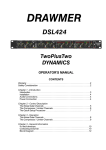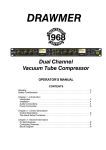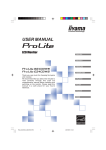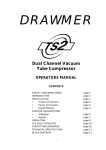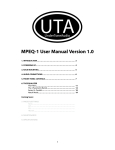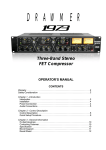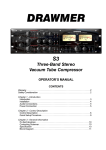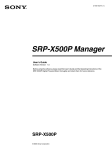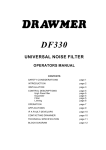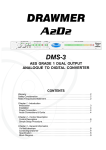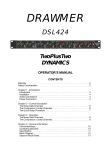Download Drawmer THREE-SUM Operator`s manual
Transcript
DRAWMER THREE-SUM Multi-Band Interface OPERATOR’S MANUAL CONTENTS Warranty . . . . . . . . . . . . . . . . . . . . . . . . . . . . . . . . . . . . . . . . . . . . . . . . . . . . . . . . . . . 2 Safety Consideration . . . . . . . . . . . . . . . . . . . . . . . . . . . . . . . . . . . . . . . . . . . . . . . . 2 Chapter 1 - Introduction Introduction . . . . . . . . . . . . . . . . . . . . . . . . . . . . . . . . . . . . . . . . . . . . . . . . . . . . . . . 3 Installation . . . . . . . . . . . . . . . . . . . . . . . . . . . . . . . . . . . . . . . . . . . . . . . . . . . . . . . . 4 Audio Connections . . . . . . . . . . . . . . . . . . . . . . . . . . . . . . . . . . . . . . . . . . . . . . . . . 4 Power Connection . . . . . . . . . . . . . . . . . . . . . . . . . . . . . . . . . . . . . . . . . . . . . . . . . 5 Chapter 2 - Control Description Control Description . . . . . . . . . . . . . . . . . . . . . . . . . . . . . . . . . . . . . . . . . . . . . . . . . 6 Chapter 3 - Operation Operation . . . . . . . . . . . . . . . . . . . . . . . . . . . . . . . . . . . . . . . . . . . . . . . . . . . . . . . . . 8 Chapter 4 - General Information . . . . . . . . . . . . . . . . . . . . . . . . . . . . . . . . . . . . . . . . . . . . . . . . . . . 10 If a fault develops Contacting Drawmer. . . . . . . . . . . . . . . . . . . . . . . . . . . . . . . . . . . . . . . . . . . . . . . 10 Specification . . . . . . . . . . . . . . . . . . . . . . . . . . . . . . . . . . . . . . . . . . . . . . . . . . . . . 10 Block Diagram . . . . . . . . . . . . . . . . . . . . . . . . . . . . . . . . . . . . . . . . . . . . . . . . . . . 11 COPYRIGHT This manual is copyrighted © 2005 by Drawmer Electronics Ltd. With all rights reserved. Under copyright laws, no part of this publication may be reproduced, transmitted, stored in a retrieval system or translated into any language in any form by any means, mechanical, optical, electronic, recording, or otherwise, without the written permission of Drawmer Electronics Ltd. ONE YEAR LIMITED WARRANTY Drawmer Electronics Ltd., warrants the Drawmer Three-Sum Multi-Band Interface to conform substantially to the specifications of this manual for a period of one year from the original date of purchase when used in accordance with the specifications detailed in this manual. In the case of a valid warranty claim, your sole and exclusive remedy and Drawmer’s entire liability under any theory of liability will be to, at Drawmer’s discretion, repair or replace the product without charge, or, if not possible, to refund the purchase price to you. This warranty is not transferable. It applies only to the original purchaser of the product. For warranty service please call your local Drawmer dealer. Alternatively call Drawmer Electronics Ltd. at +44 (0)1709 527574. Then ship the defective product, with transportation and insurance charges pre-paid, to Drawmer Electronics Ltd., Coleman Street, Parkgate, Rotherham, S62 6EL UK. Write the RA number in large letters in a prominent position on the shipping box. Enclose your name, address, telephone number, copy of the original sales invoice and a detailed description of the problem. Drawmer will not accept responsibility for loss or damage during transit. This warranty is void if the product has been damaged by misuse, modification or unauthorised repair. THIS WARRANTY IS IN LIEU OF ALL WARRANTIES, WHETHER ORAL OR WRITTEN, EXPRESSED, IMPLIED OR STATUTORY. DRAWMER MAKES NO OTHER WARRANTY EITHER EXPRESS OR IMPLIED, INCLUDING, WITHOUT LIMITATION, ANY IMPLIED WARRANTIES OF MERCHANTABILITY, FITNESS FOR A PARTICULAR PURPOSE, OR NON-INFRINGEMENT. PURCHASER’S SOLE AND EXCLUSIVE REMEDY UNDER THIS WARRANTY SHALL BE REPAIR OR REPLACEMENT AS SPECIFIED HEREIN. IN NO EVENT WILL DRAWMER ELECTRONICS LTD. BE LIABLE FOR ANY DIRECT, INDIRECT, SPECIAL, INCIDENTAL OR CONSEQUENTIAL DAMAGES RESULTING FROM ANY DEFECT IN THE PRODUCT, INCLUDING LOST PROFITS, DAMAGE TO PROPERTY, AND, TO THE EXTENT PERMITTED BY LAW, DAMAGE FOR PERSONAL INJURY, EVEN IF DRAWMER HAS BEEN ADVISED OF THE POSSIBILITY OF SUCH DAMAGES. DRAWMER Three-Sum Multi-Band Interface SAFETY CONSIDERATIONS CAUTION - MAINS FUSE TO REDUCE THE RISK OF FIRE REPLACE THE MAINS FUSE ONLY WITH A FUSE THAT CONFORMS TO IEC127-2. 250 VOLT WORKING, TIME DELAY TYPE AND BODY SIZE OF 20mm x 5mm. THE MAINS INPUT FUSE MUST BE RATED AT 230V=T80mA and 115V=T160mA. CAUTION - MAINS CABLE DO NOT ATTEMPT TO CHANGE OR TAMPER WITH THE SUPPLIED MAINS CABLE. CAUTION - SERVICING DO NOT PERFORM ANY SERVICING. REFER ALL SERVICING TO QUALIFIED SERVICE PERSONNEL. WARNING TO REDUCE THE RISK OF FIRE OR ELECTRIC SHOCK DO NOT EXPOSE THIS EQUIPMENT TO RAIN OR MOISTURE. Some states and specific countries do not allow the exclusion of implied warranties or limitations on how long an implied warranty may last, so the above limitations may not apply to you. This warranty gives you specific legal rights. You may have additional rights that vary from state to state, and country to country. In the interests of product development, Drawmer reserve the right to modify or improve specifications of this product at any time, without prior notice. 2 DRAWMER THREE-SUM OPERATOR’S MANUAL CHAPTER 1 DRAWMER THREE-SUM MULTI-BAND INTERFACE INTRODUCTION The benefits of multi-band processing, with the ability to apply different parameters to different sections of the audio bandwidth have been apparent to sound engineers for quite some time. However, ‘locking in’your audio to any one specific multiband unit can vastly reduce the creative options. The desired combination of processing to deal with low frequency energy, the vocal mid range and high frequency detail and enhancement is not necessarily available from any one manufacturer. The new Drawmer THREE-SUM opens up a whole new set of options allowing the engineer to split the audio into two or three bands and apply his or her own sonic signature to each part of the audio bandwidth. The THREE-SUM employs a high quality signal path culminating in a variable threshold, brick wall limiter section with bypass facility. To ensure transparency the limiter design is ‘two stage’, applying different processing to the H.F. content of the material. In applications where the dynamics of the material need to be retained to create an open sound, the limiter is essential for catching peaks. The THREE-SUM has been designed for use in high-end mastering and general recording applications, alternatively, it can transform a project studio, equipped only with ‘single band’ processors, into a serious multi-band facility. The Key Features are as follows: • Continuously Variable Band Splitting • Switchable Mute & Bypass On Each Band • Variable Threshold, Two Stage Brick Wall Limiter Section • Two Or Three Band Operation • VU Metering With +10dB Re-Scale Mode For Hot Output Levels • Variable Input & Output Levels • Individual Band Or Multi-Band Processing • High Quality, Minimal Signal Path With Balanced XLR Inputs/Outputs Applications: • Mastering • Stereo Sweetening • Bass Tracks • Drum Tracks • Voice Smoothing • Use More Creatively - Single Band Distortion / Reverb / Delay DRAWMER THREE-SUM OPERATOR’S MANUAL 3 INSTALLATION The THREE-SUM is designed for standard 19" rack mounting and occupies 1U of rack space. Avoid mounting the unit directly above power amplifiers or power supplies that radiate significant amounts of heat. Always connect the mains earth to the unit. Fibre or plastic washers may be used to prevent the front panel becoming marked by the mounting bolts. AUDIO CONNECTIONS The inputs and outputs are electronically balanced on conventionally wired XLRs (pin 1 screen, pin 2 hot, pin 3 cold and XLR shell is connected to chassis). The operating level is nominally +4dBu. Balanced use is recommended. • Interference: If the unit is to be used where it maybe exposed to high levels of disturbance such as found close to a TV or radio transmitter, we advise that the unit is operated in a balanced configuration. The screens of the signal cables should be connected to the chassis connection on the XLR connector as opposed to connecting to pin1. The Three-Sum conforms to the EMC standards. • Ground Loops: If ground loop problems are encountered, never disconnect the mains earth, but instead, try disconnecting the signal screen on one end of each of the cables connecting the outputs of the Three-Sum to the patchbay. If such measures are necessary, balanced operation is recommended. fig.1 TYPICAL THREE-SUM SETUP 4 DRAWMER THREE-SUM OPERATOR’S MANUAL fig.2 THREE-SUM REAR CONNECTOR WIRING POWER CONNECTION The Three-Sum unit will be supplied with a power cable suitable for domestic power outlets in your country. For your own safety, it is important that you use this cable to connect to the mains supply earth. The cable must not be tampered with or modified. The power supply socket has an integral fuse drawer containing the power fuse of the same value, to suit the mains voltage for which the unit has been supplied. Removal of the drawer is only possible with the power cord removed. The fuse should never blow under normal operation. If the fuse is suspected of having blown, then a fault will have occurred and this fault condition should be inspected by a qualified service engineer. When replacing the fuse, always comply with the Safety Instructions. If the unit is to be used with a mains input operating voltage different to that for which the unit is supplied, the following procedure must be carried out by a technically competent person, (see following diagrams) Fuse fig.3 The Location of the Fuse 1: Disconnect the unit from the mains. 2: Using a number 1 size pozidrive screwdriver, remove the eleven self -tapping screws that retain the top cover. One screw is located in the top centre of the front panel (next to the “PEAK LEVEL” text); six screws are located on the top cover; and two screws on either side. Voltage Selector Switch 3: Inside the unit slide the voltage change-over switch (SW8) until the correct (or nearest) mains input voltage is visible on the switch actuator. (see fig.4) 4: In the fuse draw change the fuse to suit the following values: For 230 Volt operation alter the fuse to a similar type rated at T80mA. For 115 Volt operation alter the fuse to a similar type rated at T160mA. fig.4 The Voltage Selector Switch DRAWMER THREE-SUM OPERATOR’S MANUAL 5 CHAPTER 2 CONTROL DESCRIPTION Input Level Trim: -10dB - +10dB Typically, the Input Trim level control is used to match the output of the preceding device to the input needs of the three compressors that the signal will pass through. Alter the “Meter Input/Output Switch” to "input" to see the effect of the input trim on the signal level to the three compressors. On an optimal signal the 0dB provides optimum headroom and signal-to-noise ratio. If the input trim is set too low little compression will occur (and, raising the overall output level of the signal will amplify the noise floor). Alternatively, increasing the input trim control pushes more level into the compressors and therefore more compression occurs. Low Split Frequency: 18Hz - 1.6kHz Sets the frequency point at which the split between low and mid bands occurs. High Split Frequency: 530Hz - 42kHz Sets the frequency point at which the split between mid and high bands occurs. THREE BAND Switches: Low: is the signal below that set by the Low Split Frequency; Mid: is the signal between that set by the two Split Frequency controls; High: is the signal above that set by the High Split Frequency control. Across all three bands Mute: In the “MUTE” position the signal for that particular band is effectively turned off. Any combination of mute is available - to hear only the signal of the low band mute the mid and high bands etc. Bypass: In the “BYPASS” position the signal for the low, mid, or high band is allowed to pass through to the summing stage without being output to a compressor. Using a combination of mute and bypass switches for the various bands allows the operator to hear and monitor only the frequencies that are required and so tune the low and high frequency settings. Output Gain: -10dB - +10dB After the three bands have returned to the Three-Sum the signal is summed back to a single stereo band. If at this point the signal is too low or so high that eccessive limiting occurs then it would be difficult to adjusts all three gain controls of each compressor whilst maintaining the low/mid/high balance, for this reason a single OUTPUT GAIN control has been incorporated. Adjust so that the limiter works only on signal peaks. 6 DRAWMER THREE-SUM OPERATOR’S MANUAL Limiter The signal culminates in a variable threshold, brick wall limiter. The limiter can be bypassed completely using this switch in the OUT position. When in bypass the unit will sum the three bands back to a full band stereo signal but then no further processing is applied (the VCA is also bypassed). This is ideal for the purists who would prefer to keep the signal path as simple as possible, but it does mean the signal level will have to managed by themselves elsewhere. Peak Level 0dB - +16dB Sets an absolute limit to the level that the output signal will not be permitted to exceed. This limiter is very fast acting enabling it to control any peaks without audible distortion.The Output Gain control should be used to ensure that the peak limiter operates only rarely if at all, if it is to be used purely for peak protection. Alternatively, it may be deliberately driven into limiting to produce creative effects. G.R. Meter -1, -3, -6, -10dB VU Meter A moving coil VU meter monitors either the level of the output or input signal. Because the meter has VU characteristics, it closely reflects what is actually being heard, though will not respond quickly enough to register short signal peaks. Meter Options: VU+10dB / VU A two-position switch adjusts the meters to show either normal output level or VU +10dB mode, which re-scales the meter for users working at ‘hot’ output levels. In other words, with the switch at VU +10dB the VU meter reads 0dB but the actual level is +10dB. Input / Output A two-position switch adjusts the meters to show either input or output level. In the input position the signal level is derived after the input gain, but preceeding the split into its three bands. This always monitors the full band of the audio signal; In the output positon the signal level comes after the three band signal has been summed and passed through the output gain and limiter. If any of the bands have been muted or bypassed this is also reflected in the meter. DRAWMER THREE-SUM OPERATOR’S MANUAL 7 CHAPTER 3 OPERATION Most conventional compressors work by processing the full-band of the music, where the whole of the signal is compressed using the same controls, however, this is by no means perfect. A problem occurs whereby when a peak occurs, such as the beat of a kick drum, all of the signal is effectively "turned down" by the compressor, including the vocals, guitar, hi-hats etc. even though these may not need compressing. In addition, when processing complex mixes using a conventional compressor, you can easily reach the point where gain pumping becomes audible, with high-energy, low-frequency sounds affecting the gain of the whole mix. Multi-band compressors were designed to avoid these problems, by treating different sections of the frequency spectrum independently. The Drawmer Three-Sum has been designed to allow the audio to split into three separate frequency bands by means of a crossover circuit, each band then being treated with a separate compressor and, at the output, the various bands are again combined to provide a full-range signal. In addition, unlike conventional three band compressors, the Drawmer Three-Sum allows the three signals to be sent to three independent compressors, each giving their own unique Setting up the Cross-Over Points. Which cross-over frequencies should be used? This invariably depends on the material being processed, the settings of a mix will be very different from that of a full drum kit, however the general rule of thumb is that in most circumstances the cross-over points need to be set in such a way as to separate the main bass and treble sounds from the mid-range. Keeping in mind that instruments have harmonics that can extend over several octaves, the goal is to try to partition your mix into bands. Play your mix, and mute the bands not required. Now you can hear exactly which frequencies are contained in each band, and can tune in to the signal. 8 flavour to the music - some warmer at bottom end compression, others providing an enhanced top end. The control is entirely with the operator. The Drawmer Three-Sum, where each band's compressor can be adjusted separately, is a very versatile and powerful tool. For instance, the perceived amount of bass can be increased by setting a higher ratio or lower threshold for the bass band than in the mid and high bands. Similarly, if you feel the mid frequencies of the mix are lacking, simply turn up the output level of the mid-band compressor - using more compression in the mid-band can often help lift out the vocals. Likewise, compress the top end a little harder to give it more brightness or enhancement. If the gain reduction of each band is controlled by adjusting the makeup gain knobs on each of the three compressors then the overall levels of signal peaks will not increase but the sound will be much more impressive. However, no matter how much care is taken, it is quite possible to fully control the signal in each band but still end up with a signal that is too high in level when the bands are combined. Therefore an output gain control has been provided on the Three-Sum to trim the whole stereo signal, followed by a fast acting limiter that will catch any overshoots. To ensure transparency the limiter design is ‘two stage’, applying different processing to the H.F. content of the material. In applications where the dynamics of the material need to be retained to create an open sound, set the output gain so that the limiter only activates on fast signal peaks. On a full mix the kick drums and bass instruments will be mainly in the low band while the mid band should be set wide enough to accommodate the full vocal range, except for perhaps the highest harmonics and breath noises - DRAWMER THREE-SUM OPERATOR’S MANUAL setting a crossover point in the middle of the vocal range can completely mess up the vocal sound. In general it's best to set the low crossover point below the vocal frequency range (about 150Hz to 250Hz) and set the high crossover point between 5kHz and 8kHz (but no lower 3kHz) to catch the brightness of an acoustic guitar or cymbals etc, and embellish the feeling of detail and air, creating an effect similar to that of using an enhancer. Using Multi-Band Compression on Single Instruments. The Drawmer Three-Sum can be used to very good effect during the recording stages. Because the signal is split into three each band can be compressed and modified much more precisely to add bass, or enhanced top end brightness of a single instrument, such as a piano or drum kit. Obviously, all instruments are different and require different settings. As before a good starting point is to mute the unwanted bands and to tune into the required frequencies using the "Low Split Frequency" and "High Split Frequency" controls. This ensures that the overall sonal quality of the instrument is compressed, but the unwanted noises, such as rumble from traffic, or amplifier hiss etc. are not. On vocals multi-band compressors can be used to alter the timbre. Compressing the lower band will provide a much thicker voice giving it presence, whilst In all cases listen to the audio and try to determine where the signal is lacking, the different ranges covered by the various instruments and sounds and adjust the crossover points accordingly. However, try to be subtle, remember that the more make-up gain you apply, the more you will be bringing up the background noise — tape hiss etc. Careful selection of crossover points and ratio/threshold settings can help to subdue any adverse effects, but remember, over processing is always damaging to a piece of music. compressing the top band will improve air and give a more sweet sound to what was a quite dull voice. Remember, any gain should be controlled by the three individual compresses before being summed by the Three-Sum. Subtlety is the key. Other Uses. The Drawmer Three-Sum has primarily been designed for use as a three band compressor, however, the fact that it uses external compressors after splitting the signal into its three bands opens up endless other uses. The signal need not pass to a compressor, try using it to add distortion or reverb to only the bass of a guitar or other instrument. Imagine having a lead guitar with over driven bottom strings, but a clear crisp tone to the top strings. DRAWMER THREE-SUM OPERATOR’S MANUAL 9 CHAPTER 4 GENERAL INFORMATION It is the responsibility of the installer to ensure that the continuous power rating of the speakers is not exceeded, as Drawmer Electronics Ltd will not accept any responsibitlity for speaker damage caused by incorrect settings. IF A FAULT DEVELOPS CONTACTING DRAWMER For warranty service please call Drawmer Electronics Ltd. or their nearest authorised service facility, giving full details of the difficulty. Drawmer Electronics Ltd., will be pleased to answer all application questions to enhance your usage of this equipment. Please address correspondence to: A list of all main dealers can be found on the Drawmer webpages. On receipt of this information, service or shipping instructions will be forwarded to you. No equipment should be returned under the warranty without prior consent from Drawmer or their authorised representative. For service claims under the warranty agreement a service Returns Authorisation (RA) number will be issued. Write this RA number in large letters in a prominent position on the shipping box. Enclose your name, address, telephone number, copy of the original sales invoice and a detailed description of the problem. Authorised returns should be prepaid and must be insured. Drawmer (Technical Help line) Coleman Street Parkgate Rotherham S62 6EL UK Alternatively contact us by E-mail on : [email protected] Further information on all Drawmer dealers, Authorised service departments and other contact information can be obtained from our web pages on: http://www.drawmer.com All Drawmer products are packaged in specially designed containers for protection. If the unit is to be returned, the original container must be used. If this container is not available, then the equipment should be packaged in substantial shock-proof material, capable of withstanding the handling for the transit. THREE-SUM MULTI-BAND INTERFACE DATA SPECIFICATION INPUT IMPEDANCE Input Impedance Maximum Input Level THD & Noise 20k Ohms +20dBu -85dB POWER REQUIREMENTS 230Volt or 115V at 50-60hZ, 13VA OUTPUT Output Impedance Maximum Output Level 50 Ohms +21dBu FUSE RATING <20Hz to 20kHz +/- <.5dB <17Hz to 28kHz -1dB <10Hz to 47kHz -3dB FUSE TYPE T80mA for 230Volt, T160mA for 115Volt Conforming to IEC 127-2 BANDWIDTH 20mm x 5mm, Class 3 Slo-Blo, 250Volt working CASE SIZE CROSSTALK 482mm (W) x 44mm (H) x 200mm (D) better than 63dB @ 10kHz WEIGHT 10 DRAWMER THREE-SUM OPERATOR’S MANUAL 4Kgs BLOCK DIAGRAM Three-Sum ver 01 B 15/06/06 DRAWMER THREE-SUM OPERATOR’S MANUAL 11











